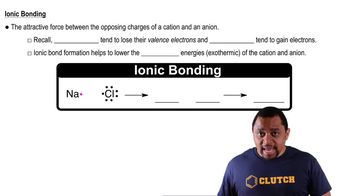Textbook Question
What is the Lewis symbol for each of the following atoms or ions? (c) Sn2+
23
views
 Verified step by step guidance
Verified step by step guidance



What is the Lewis symbol for each of the following atoms or ions? (c) Sn2+
(a) Using Lewis symbols, make a sketch of the reaction between magnesium and oxygen atoms to give the ionic substance MgO
Predict the chemical formula of the ionic compound formed between the following pairs of elements: (b) Mg and O (c) Zn and Cl
Predict the chemical formula of the ionic compound formed between the following pairs of elements: (d) Li and O.
Which ionic compound is expected to form from combining the following pairs of elements? (a) calcium and nitrogen (b) cesium and bromine (c) strontium and sulfur